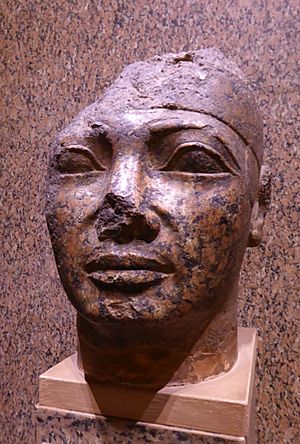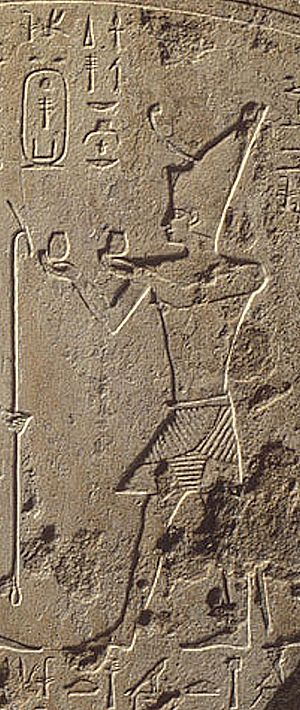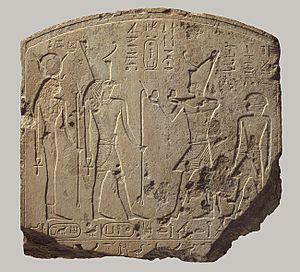Shebitku facts for kids
Quick facts for kids Shebitku |
|
|---|---|

Shebitku's statue in the Nubian Museum
|
|
| Pharaoh | |
| Reign | 714–705 BC (25th Dynasty) |
| Predecessor | Piye |
| Successor | Shabaka |
| Consort | Arty |
| Died | 705 BC |
Shebitku (also known as Shabataka or Shebitqo) was an important pharaoh of ancient Egypt. He was the second ruler of the Twenty-fifth Dynasty of Egypt, a time when Egypt was ruled by kings from the land of Kush (modern-day Sudan). Shebitku ruled from about 714 BC to 705 BC.
He was the son of Piye, who was the founder of this dynasty. Shebitku's throne name, Djedkare, meant "Enduring is the Soul of Re". His queen was Arty, who was also a daughter of King Piye.
Contents
Shebitku Ruled Before Shabaka
For a long time, historians thought that Shebitku ruled after another pharaoh named Shabaka. However, new discoveries and research have changed this idea. Most experts now agree that Shebitku ruled before Shabaka.
One important piece of evidence comes from inscriptions found at the Karnak Temple Complex in Egypt. These are called Nile Level Texts. An inscription from Shebitku's third year was carved before an inscription from Shabaka's second year. This shows that Shebitku was already king when Shabaka's inscription was made.
Another clue comes from the title of "Divine Adoratrice of Amun". This was a very powerful religious position held by women. During Shebitku's reign, a woman named Shepenupet I held this title. But during Shabaka's reign, a different woman, Amenirdis I, held it. This change suggests that Shebitku ruled first, and then Shabaka.
The design of the royal tombs also helps. The tombs of Piye and Shebitku at El Kurru have a similar style. Their burial chambers were open-cut with a special type of roof. But the tombs of Shabaka and later kings had fully tunneled burial chambers. This was an improvement, and it suggests that Shabaka's tomb style came later.
Even the small statues called shabtis (which were placed in tombs) give us clues. Shebitku's shabtis are small and have simple writings. They are similar to those of Piye. But Shabaka's shabtis are larger and have more detailed inscriptions. This also points to Shebitku ruling before Shabaka.
Was There a Co-Rule with Shabaka?
Some people once thought that Shebitku and Shabaka might have ruled together at the same time. This is called a "co-regency."
One reason for this idea was a stone slab (called a stela) that seemed to show both kings seated together. However, it was later discovered that this stela was a fake. So, it cannot be used as proof.
Another idea came from a Nile Level Text from Shebitku's third year. It talks about Shebitku appearing as king in the temple of Amun at Karnak. Some thought this meant he was crowned after two years of co-ruling with Shabaka. But experts now believe this inscription simply records a special visit by Shebitku to the temple. He was already king, and this visit was to show that the god Amun approved of his rule.
Historians have looked closely at all the evidence. They have concluded that there was no co-regency between Shebitku and Shabaka. Each king ruled on their own.
Shebitku in the Timeline
An important discovery in 1999 helped confirm Shebitku's place in history. An inscription from the Assyrian king Sargon II (who ruled from 722-705 BC) was found in Iran. This inscription, from around 707/706 BC, says that Shebitku, the king of Egypt, handed over a rebel leader named Iamani to Sargon II.
This inscription is very important because it clearly names Shebitku as the king of Egypt at that time. Before this, some thought Shabaka was king then. This discovery helped historians place Shebitku's reign more accurately. It shows that Shebitku was ruling Egypt by April 706 BC at the latest.
Historians now agree that Shebitku was the king of Egypt when this event happened. He was not just a local ruler or a co-regent.
Shebitku and Herodotus' Sethos
The ancient Greek historian Herodotus wrote about Egypt in his book Histories. He mentioned a pharaoh named Sethos who was a High Priest of Ptah. Herodotus said Sethos defeated the Assyrians with help from the gods.
Many historians believe that Herodotus' "Sethos" was actually Shebitku. The name "Sethos" is probably a slightly changed version of "Shebitku." Herodotus' story was later used in a fantasy novel, and it has influenced some modern ideas about ancient Egypt.
See also
 In Spanish: Shabitko para niños
In Spanish: Shabitko para niños



